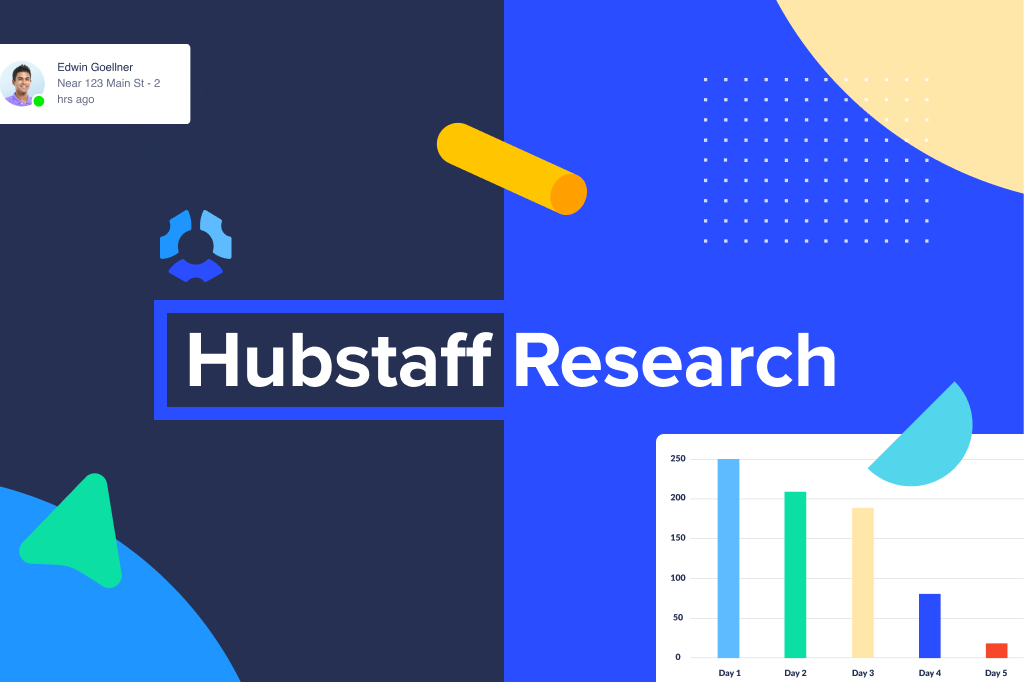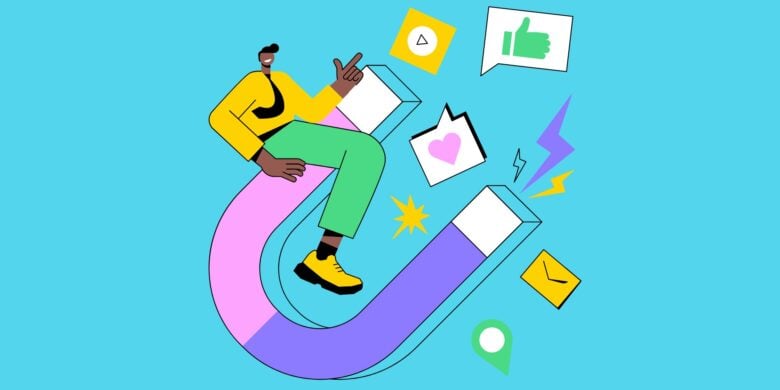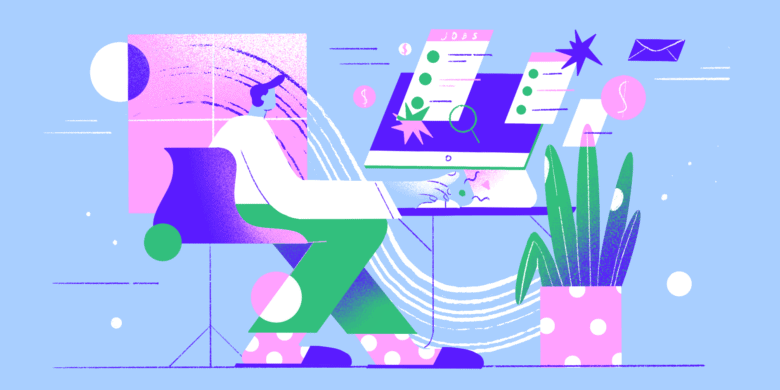- Remote employees spend more time each day on focused tasks
- Annually, remote work protects an estimated 62 hours’ worth of work that in-office teams lose due to daily interruptions
According to a recent analysis of work habits, measured distractions, and daily activity data, remote work arrangements make more sense for deep, focused work that can tolerate few interruptions. That’s because remote team members engage in more focused time and see fewer interruptions.
These findings are the core takeaway of Hubstaff’s first look into meaningful workforce data. We’ve begun reviewing objective workforce data available to us to better understand the modern worker and how they can thrive in remote environments.
This result benefits many early adopters of remote and hybrid flexibility — especially developers, marketers, virtual assistants, and others who rely on freelancers and hourly contractors.
Many companies are turning to return-to-office mandates under the impression that this would increase productivity and engagement. At Hubstaff, we’ve seen global brands succeed with remote work for over a decade.
The data bears that, for most roles, organizations should have few concerns about a return to the old, on-site way of doing things.
Let’s dive deeper into this research and what these gains could mean for your organization.
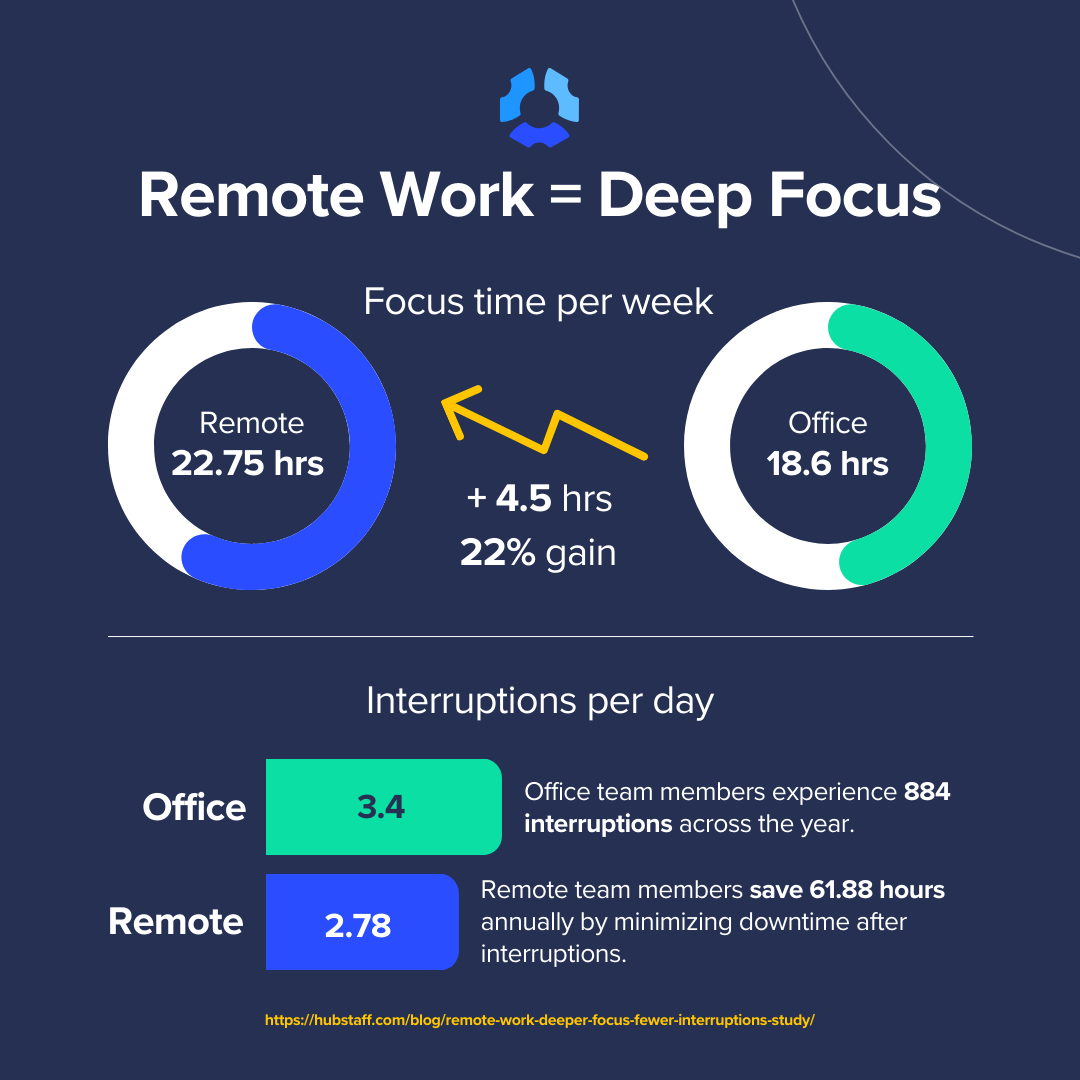
Boost your team’s efficiency with Hubstaff's productivity tools
Remote’s gains for focused work
Based on Hubstaff data, remote teams engage in more “focus time”* in terms of overall weekly minutes and as a greater percentage of their work time.
On average, focus time (as a percentage of total working time) is higher for remote team members at 59.48% of their week. This amount comes in more than ten points higher than the 48.5% of an average in-office team member.
When we look at focus time in minutes per day, the average remote worker spends 273 minutes (4.55 hours) in focus time on a typical day. The average in-office team member is in a focused state for just 223 minutes (3.72 hours).
Work weeks and times vary, especially in remote. However, if we apply this to a standard five-day work week, remote workers average roughly 22.75 hours per week in focused time compared to the 18.6 hours of their in-office counterparts.
Each week, the average remote team member will spend 4.15 more hours in a focused state of work, about a 22% gain compared to the average in-office worker.
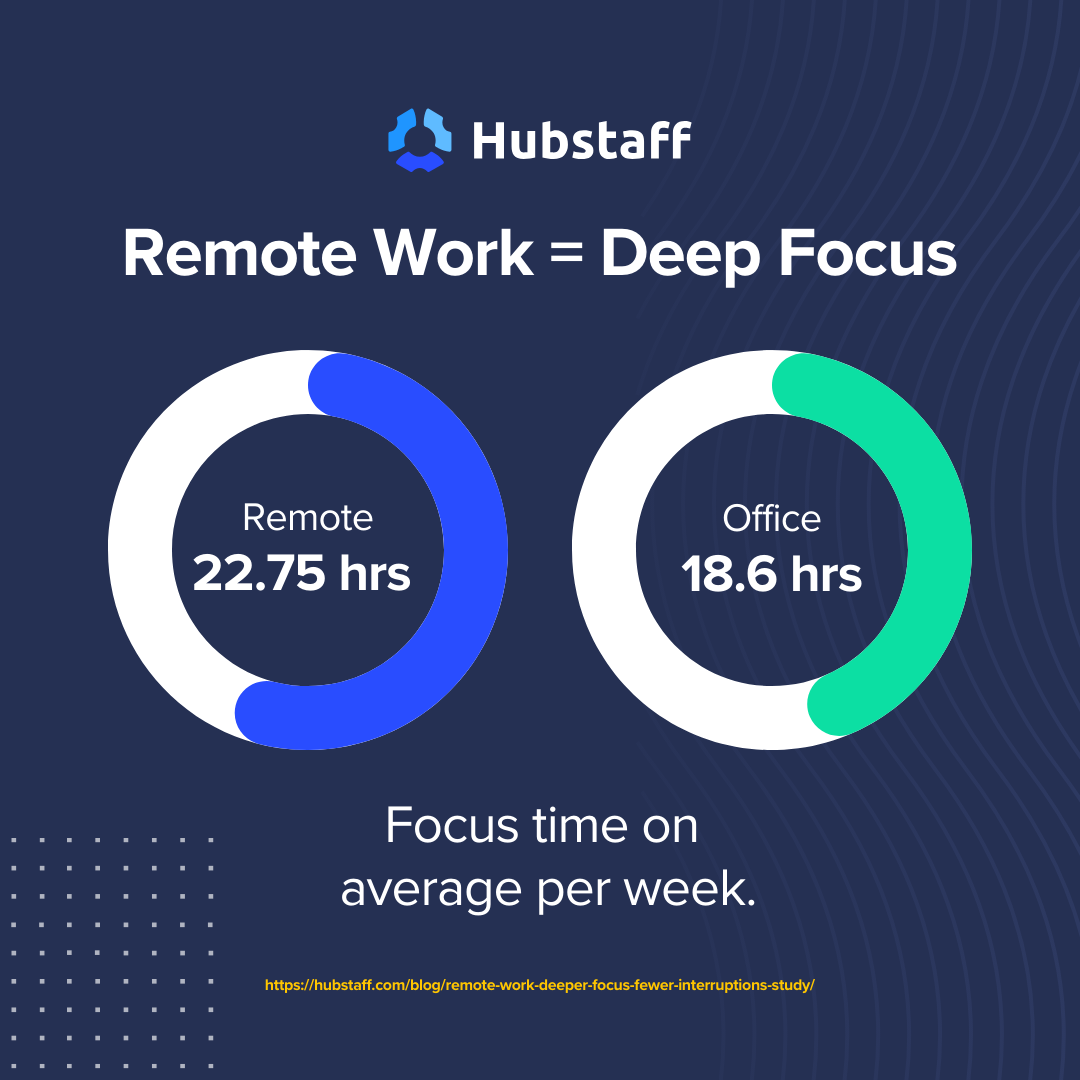
Our analysis supports workers’ claims that they can prioritize work and minimize distractions in their home environment. It also suggests that a remote work environment may have fewer demands that pull workers away from their core tasks.
An important distinction is that focus time is a tracked element, not a self-reported value. We did not ask workers to compare their feelings of distractions or make a comparison to a past in-office state. We also aimed to create an objective measure independent of other factors or perceptions.
Why this matters to modern business success
Remote teams are often portrayed as easily and often distracted by home and environmental factors. Some return-to-office mandates attempt to place the onus on employees by pointing to the “public health crisis” known as remote loneliness when noticing an uptick in employee burnout.
However, multiple past studies on work-life balance have shown that remote workers balance social and home demands (e.g., chores, cleaning, childcare) without significantly impacting work performance.
Our data suggests this performance is more profound. There’s plenty of data to make the case that remote team members can better focus on tasks compared to their office counterparts.
One could argue that they could link this outcome to everyday factors like technological differences. There are also individual circumstances like creating a distraction-free work environment or adjusting flex-work schedules to be at different times than household demands.
While our data does not point to specific causation, we believe it shows the potential for remote work to support and strengthen careers requiring a deeper focus. There are also a number of roles that require prolonged periods of focused work that may benefit from flexible work schedules:
- Programmers
- Writers
- Accountants
- Data Entry Specialists
- Project Managers
- Virtual Assistants
If a company identifies a skills or productivity gap involving deep, focused work, hiring remotely or offering staff flexibility in how they work may be key to addressing that challenge effectively.
Remote workers face fewer interruptions than in-office teams
Remote workers also tend to have fewer interruptions during periods of deep concentration. According to our analysis, remote workers average 2.78 interruptions during focused work per day, compared to 3.40 for office staff.
If we expand that average across an entire year, in-office staff have their focused work interrupted an average of just 884 times annually (assuming a standard 260 workdays per year).
Remote workers would experience roughly 18% fewer interruptions (722.8) over the same time period.
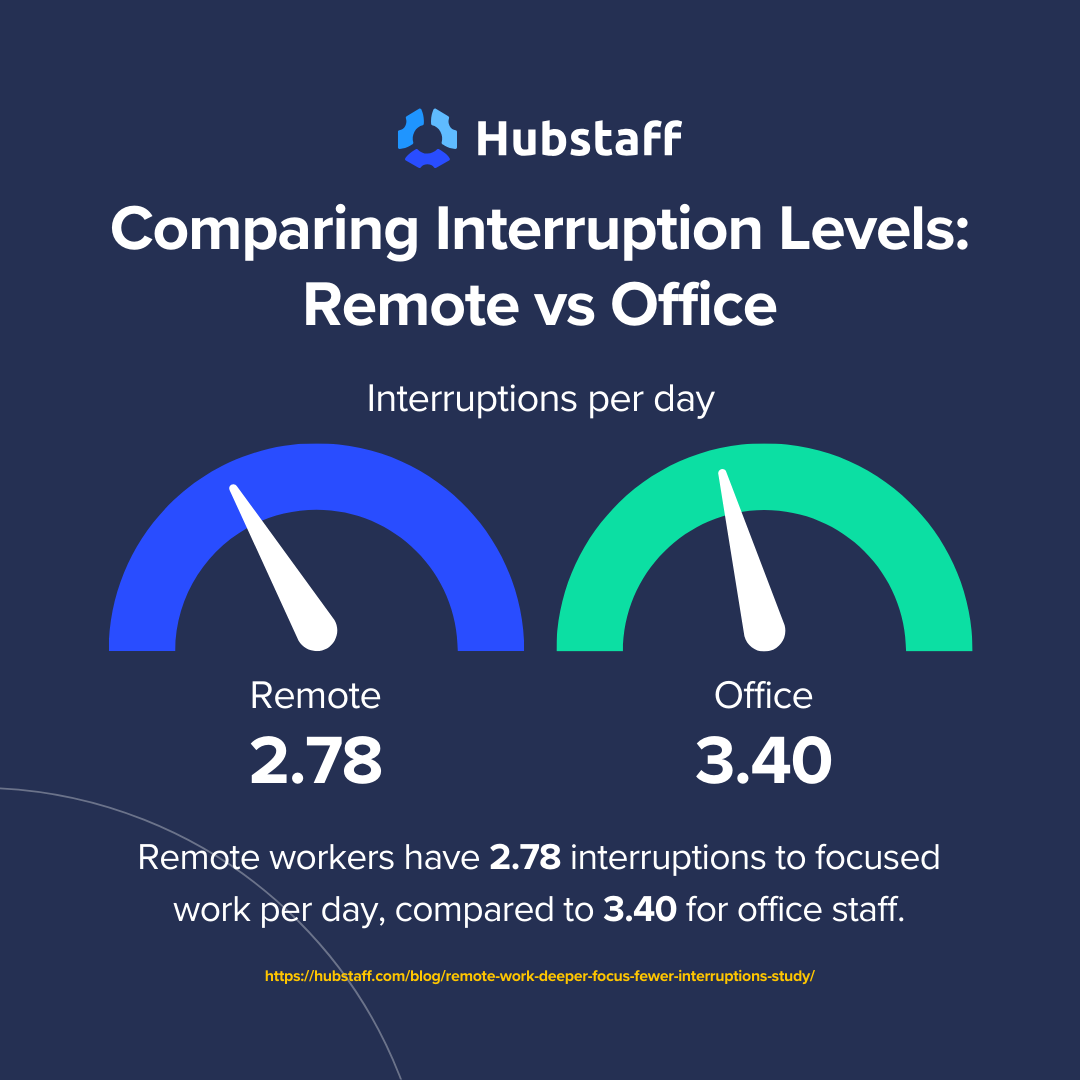
Enable your team to stay on task and on target
“Interruptions to focused work defeat its purpose,” says Hubstaff CTO and report co-author Alex Yarotsky. “These interruptions can also introduce errors and create the need for rework. The more frequent they are, the greater the impact on the person and project. Our research is one part of the equation for companies figuring out how much those interruptions, especially in office environments, are costing them.”
A research study from the University of California at Irvine found that it takes 23 minutes, on average, for most people to get back on task after an interruption.
The more complex a task is, the longer it takes for someone to recover. As interruptions increase over time, so does the stress related to a project and the error rates of work by those being interrupted.
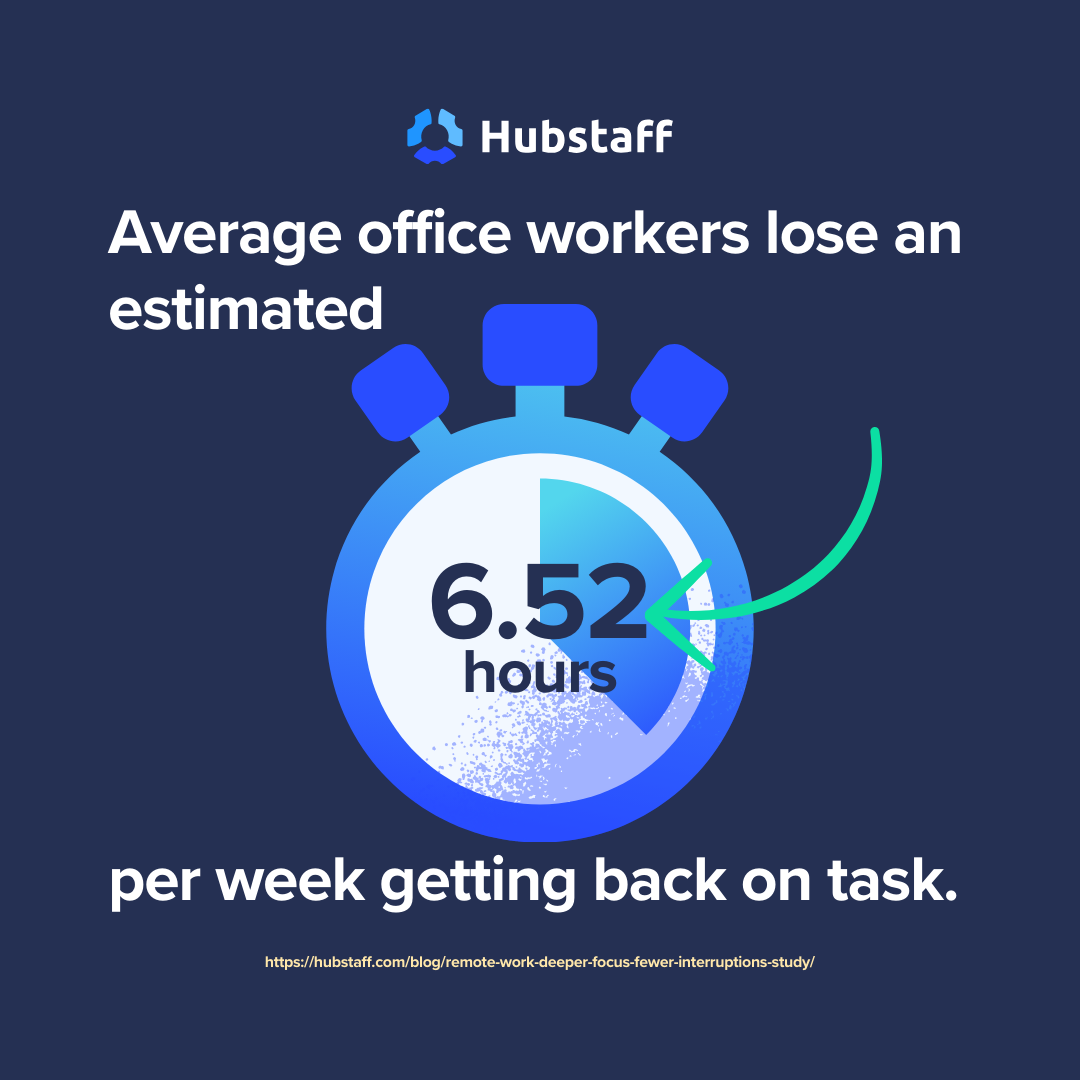
Combining that with our interruption data, the average office worker experiencing an average amount of time to refocus would lose 6.52 hours each week just to get back to what they were doing. In a standard 40-hour workweek, that’s nearly a day’s worth of work lost.
It also doesn’t cover any time lost during the interruption — such as the 15 minutes their coworker stops to chat during a moment of deep focus.
Remote employees, facing an average of 13.9 interruptions per week, have 1.19 fewer hours wasted in this manner per week compared to in-office teams. When comparing this across an entire year, remote employees eliminate 61.88 hours of wasted time required to get back on track after an interruption.
That’s more than one-and-a-half weeks of work time gained back by reducing distractions.
The potential cost of interruptions
It can be hard to quantify down to the minute how much distractions can impact a company’s bottom line. So, let’s take that information on getting back on task and put it in terms of dollars ($USD).
Relying on Zippia’s office worker salary data for 2023, we can see how much interruptions may cost you per worker in the United States based on where they work — assuming the remote and in-office team members are each paid the same rate.
Cost of Interruptions for Office and Remote Workers by State
| State | Avg. Salary | Hourly Rate | Cost of time lost returning to tasks (remote) | Cost of time lost returning to tasks (in-office) | Annual savings from enabling remote work (per worker) |
| U.S. Average | $41,003 | $19.71 | $5,461.12 | $6,679.06 | $1,217.95 |
| California | $65,212 | $31.35 | $8,686.25 | $10,623.47 | $1,937.22 |
| Georgia | $50,241 | $24.15 | $6,691.32 | $8,183.63 | $1,492.31 |
| Nevada | $55,520 | $26.69 | $7,395.09 | $9,044.35 | $1,649.26 |
| Oregon | $47,405 | $22.79 | $6,314.50 | $7,722.77 | $1,408.27 |
| District of Columbia | $57,785 | $27.78 | $7,697.10 | $9,413.72 | $1,716.62 |
| Arizona | $53,219 | $25.59 | $7,090.31 | $8,671.60 | $1,581.29 |
| North Carolina | $45,304 | $21.78 | $6,034.66 | $7,380.52 | $1,345.86 |
| Virginia | $47,231 | $22.71 | $6,292.34 | $7,695.66 | $1,403.33 |
| Washington | $46,852 | $22.52 | $6,239.69 | $7,631.28 | $1,391.59 |
| Texas | $44,374 | $21.33 | $5,909.97 | $7,228.03 | $1,318.05 |
Salary and hourly data via Zippia
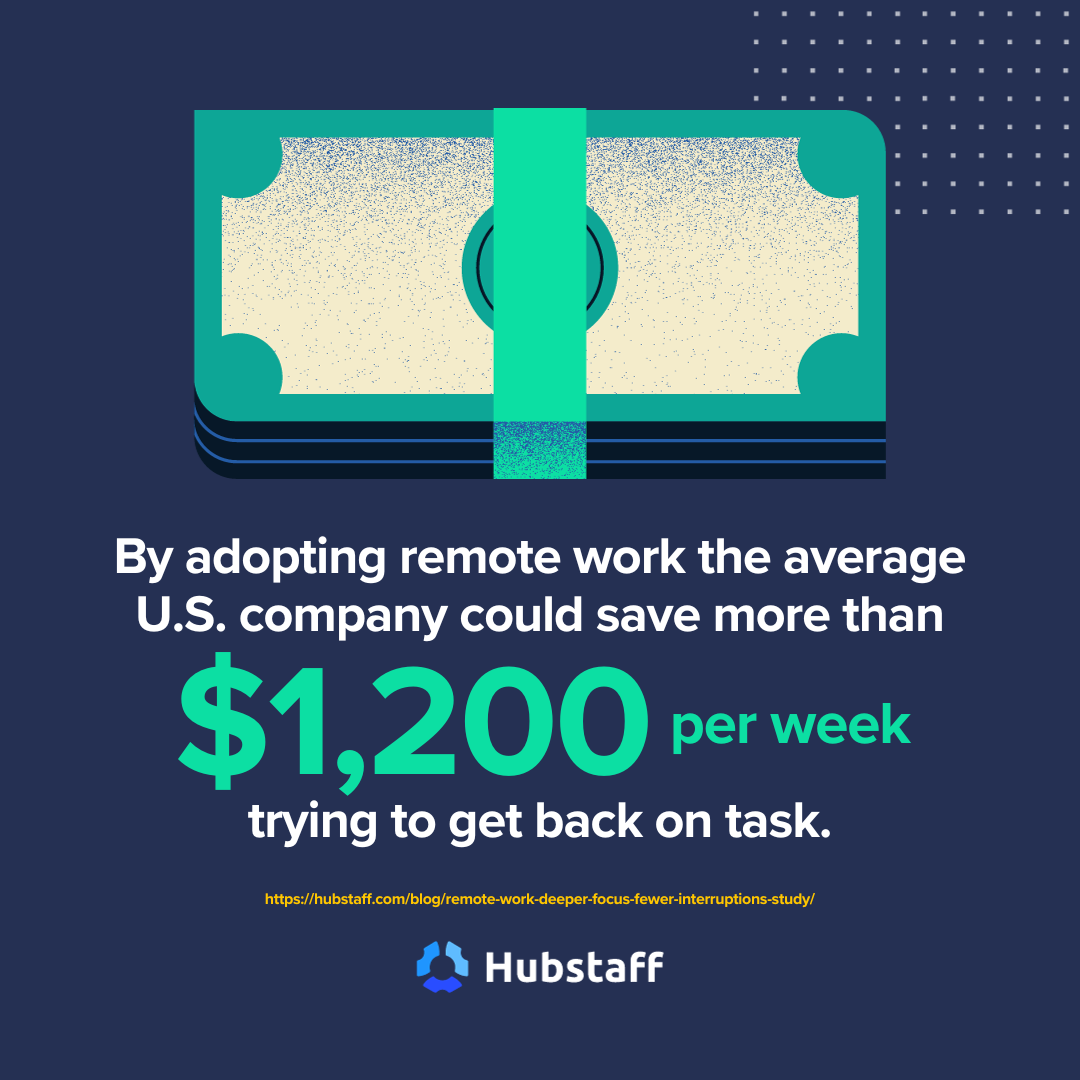
Protecting work and efficiency through reduced interruptions
Remote work allows individuals to carve out a space to focus and experience fewer interruptions. Using the same averages, remote workers keep about 15 minutes more in their work week just in recovery time. Fewer interruptions likely also mean less time lost due to those interruptions, creating plenty of potential for gains in productivity.
Some of the most common reasons for being able to reduce interruptions and carve out this time include:
- Remote communication technology typically has options to set focus time and/or mute notifications.
- Remote employees likely work around fewer people overall.
- Remote workers report a greater ability to create privacy and reduce interruptions.
- There are reduced opportunities for impromptu meetings or dropping by someone’s desk in a remote setting.
- Lunch breaks can be easier to manage and potentially shorter than when office workers go out for lunch.
- Many activities in offices that were set for specific times, such as announcements or events in a break room, shift to asynchronous communication for remote workers.
Our analysis applied the same interruption standard to all people and work. Some studies that challenge the viability of remote work have attempted to categorize interruptions in the office as work-related interruptions. That effort is likely limited in accurately assessing the nature of the interruption and its impact.
We believe that fewer interruptions (regardless of their nature) positively impact the potential for work quality.
Applying Hubstaff data to your operations
Work is a complex engagement of social factors, tasks, time management, self-direction, and guidance from management and leaders. Offering the flexibility of remote options to staff does not simplify this dance but instead shifts the balance of control in favor of the team member. The nature of the work and the individual performing will also play a significant role in the success or productivity gains that remote and hybrid settings offer.
We believe our initial analysis points to greater potential for those gains in areas of work that require deep focus and tolerate fewer interruptions. In our experience, this lends itself nicely to the technology sector, which has already adopted many facets of a global workforce.

Hubstaff is just beginning our research journey and will continue to work to better understand the needs of remote workers, the barriers they face, and areas where they outperform traditional work.
In the interim, the outlook is strongest for hybrid work arrangements that allow companies to test the waters and look for potential benefits of remote work. Adoption of flexible arrangements can vary significantly depending on job type and company sector.
Remote work proved to be a boon for companies during the 2020 pandemic and related economic downturns, so its potential resurgence as a cost-protective measure means we should not count it out from any sector.
In the meantime, we encourage companies to consider the possibility of remote work as a way to secure desirable talent and encourage deeper work. Tools like Hubstaff Insights can help address productivity concerns by offering hard, personalized data to help companies and individuals see the value of their work.

A note about our data and methodology
At Hubstaff, we’ve based our preliminary research on objective measures of anonymized work data collected within our platform. We sent a survey to Hubstaff users and asked them to detail where they worked (in the office, remote, or hybrid) but not how they worked. Then we utilized Hubstaff tracking information for elements such as focus time, interruptions, and types of work performed.
We believe this sets our findings apart from most other remote work and productivity reporting, which are typically based solely on survey data.
Upon securing our dataset, we conducted an exploratory data analysis to identify outliers and examine the characteristics of each distribution. We applied the Central Limit Theorem to each data subset, generating aggregated mean values, and subsequently used the Shapiro-Wilk Test on these means to verify the normality of the data distribution. Depending on the identified distribution characteristics, we employed either a Two-Sample Z-Test, the Mann–Whitney U Test, or the Kruskal-Wallis H Test to assess the statistical significance of our findings.
*Hubstaff defines “focus time” as:
- At least 30 minutes of continuous time tracked to a single project or task
- Less than 90 seconds of unproductive app or URL usage
- And less than 90 seconds spent in collaborative or unproductive categories
- This also includes communications, meetings, entertainment, news, social media, or shopping.
About the study authors
Alex Yarotsky
Alex Yarotsky is the Chief Technology Officer at Hubstaff, leading engineering efforts across the organization. He started at Hubstaff as the VP of Engineering in 2019 and then joined the C-suite in 2022. Alex has helmed development and software engineering in companies focused on emerging technologies and workforce management. He plays an integral part in managing Hubstaff’s fully remote workforce. Connect with him on LinkedIn.
Geoff Whiting
Geoff Whiting is the former Content Strategy Manager at Hubstaff. With a background in journalism and psychology, he developed content and communications strategies focused on the modern workforce and the tools it needs to thrive in remote and hybrid environments. Geoff has been a remote worker for more than 15 years and advocates that treating employees with trust and respect yields substantial benefits for organizations and their customers. Connect with him on LinkedIn.
The initial press release announcing this study can be found here.
Most popular
The Critical Role of Employee Monitoring and Workplace Security
Why do we need employee monitoring and workplace security? Companies had to adapt fast when the world shifted to remote work...
15 Ways to Use AI in the Workforce
Whether through AI-powered project management, strategic planning, or simply automating simple admin work, we’ve seen a dramatic...
The AI Productivity Panel: Lessons From Leaders on What’s Working (and What’s Not)
When I moderated this AI productivity panel, I expected a solid conversation. What I didn’t expect was the flood of real-world i...
Employee Performance Dashboards: Templates, Tools, and Best Practices
Keeping track of how your team’s really doing can be tricky. Spreadsheets pile up, one-on-ones only tell part of the story, and...
